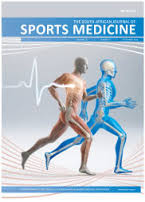An evaluation of bicycle-specific agility and reaction times in mountain bikers and road cyclists
DOI:
https://doi.org/10.17159/2078-516X/2020/v32i1a8576Abstract
Background: Cycling is a popular recreational and competitive sport with many health benefits but also significant risks, with 85% of recreational cyclists reporting an injury each season. The most common mechanism of injury is through a loss of control of the bicycle, and collisions with other objects. Reaction time and agility in cyclists may contribute to the ability to control a bicycle.
Objectives: To evaluate bicycle-specific agility and reaction time in cyclists.
Methods: The study was a cross-sectional observational study. Thirty-five cyclists (27 males, eight females) participated in this study. Participants attended a single testing session where they completed a bicycle-specific agility test, and online simple and choice reaction time testing while cycling at three different exercise intensities.
Results: There was a significant difference in agility between males and females (p=0.01). There was also a significant difference in choice reaction time between cycling at ‘light’ and ‘very hard’ intensities (p=0.004), and a significant positive relationship between agility and simple reaction time at a ‘hard’ intensity.
Discussion: Choice reaction time improved at ‘very hard’ cycling intensity, supporting the theory that increased exercise intensity improves cognitive arousal. This reaction time may be essential as a means to avoid collisions and falls from bicycles. Bicycle-specific agility appears to be related to simple reaction time, but there are no existing validated bicycle-specific agility tests available. The value of the tests undertaken by the authors needs to be assessed further.
Conclusion: Choice reaction time was significantly decreased in high intensity cycling compared to cycling at low intensities. Further prospective studies are needed to establish links between reaction times and bicycle-specific agility.
Downloads
Downloads
Published
Issue
Section
License
The South African Journal of Sports Medicine reserves copyright of the material published. The work is licensed under a Creative Commons Attribution 4.0 (CC BY 4.0) International License. Material submitted for publication in the South African Journal of Sports Medicine is accepted provided it has not been published elsewhere. The South African Journal of Sports Medicine does not hold itself responsible for statements made by the authors.
How to Cite
- Abstract 717
- PDF 597





.png)